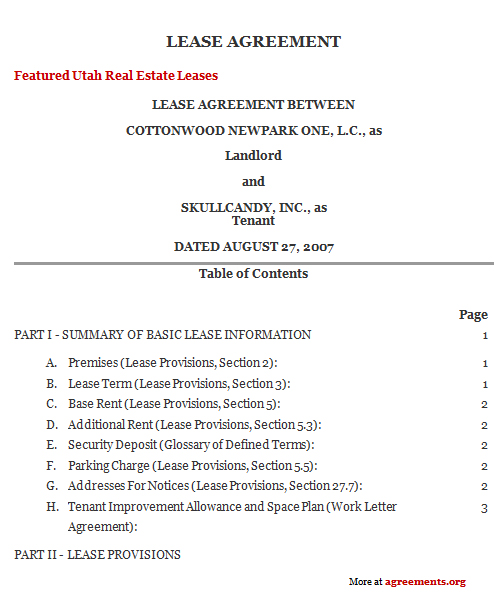A Utah lease agreement is a lease agreement between the party leasing the property (the Lessor) and the party to whom the property is leased (the Lessee). This agreement is valid in the state of Utah and is normally for a specified period of time. This lease agreement can be used for commercial or residential properties. The agreement can be for a period of a year with an option to renew or it may be a month-to-month lease. Under Utah laws, a month-to-month lease may be terminated with notice of at least fifteen days.
When Do You Need a Utah Lease Agreement
A Utah lease agreement is needed when a property is being leased from one party to another. The lease agreement helps to lay down the terms and conditions of the lease. It also states the duties and obligations of the tenant and how he shall use the leased property.
The purpose of the Utah lease agreement is to formally lay down the terms and conditions of the lease. The agreement takes into account all rights and obligations of both the parties and makes sure that the interests of both parties are protected under the agreement.
The most commonly used Utah lease agreements are standard annual residential lease agreement, the lease to own agreement, the month to month agreement, a subletting agreement, a roommate agreement, and a commercial lease.
Inclusions in a Utah Lease Agreement
The agreement must clearly state the names of the parties between whom the agreement is entered into. This will include the Lessor and the Lessee. Under Utah laws, the landlord or the property management company must be identified in the agreement. This includes identifying any individual or business who is authorized to act on behalf of the landlord.
The lease agreement must include a description of the premises and how the premises may be used. It must also lay down the amount of rent and security deposit. Under the laws of Utah, there is no limit on the amount of security deposit that can be charged by the landlord, however, the security deposit must be returned to the tenant thirty days after the tenant moves out.
The term of the lease and whether it can be renewed must also be mentioned.
How to Draft a Utah Lease Agreement
The following are the steps to follow while drafting a Utah lease agreement:
- Decide on what type of lease will suit both the parties
- Decide the term of the lease
- Decide the amount of rent that will be payable by the lessee and the schedule for such payment
- Decide the number of occupants who will occupy the leased premises.
- Draft the agreement while providing for the obligations and duties of both the parties to the agreement
- Lay out the events of defaults and the remedies for them
- Make sure the agreement is signed by both the parties
Benefits of a Utah Lease Agreement
- The lease agreement provides a solid evidence of the existence of property having being leased to the lessee.
- The agreement will serve as evidence of the terms and conditions under which the property has been leased.
- It helps to secure the interests of both the parties
- If the lease agreement is created, the landlord has the right to terminate the lease in case of a default on part of the tenant and the right to recover actual damages.
Consequences of Not Having a Utah Lease Agreement
- If a lease agreement is not entered into between the parties, there will not be any evidence that such a lease ever existed.
- In case of default on part of either party, the other party has limited remedies available.
Key Clauses in a Utah Lease Agreement
The following are the key terms of a Utah lease agreement:
- Description of the premises
- How the premises will be used
- Term of the lease
- Amount of rent
- Schedule for payment of rent
- Occupants
- Amount of security deposit
- Utilities and services
- Improvements and alterations made by the lessee
- Default on rent payment
- Nuisance
- Obligations of the tenant
- Maintenance of premises
- Repairs by landlord
- Repairs by tenant
- Renewal of lease
- Landlord’s failure to give possession
- Inspection by landlord
- Defects in leased premises
- Terms for assignment and sublease
- Events of default
- Abandonment and re-letting
- Limitation of liability
- Indemnity and public liability insurance
- Modification of the agreement
- Governing law and jurisdiction
- Termination of the agreement
What Happens When You Violate a Utah Lease Agreement
When a Utah lease agreement is violated by the tenant, the landlord shall serve a notice on him to remedy the breach within a specified time period. If the tenant does not remedy the breach within such time, the landlord shall have the right to terminate the lease agreement. The landlord may recover actual damages and obtain injunctive relief for non-compliance by the tenant with rental agreement or the obligations of the tenant under the applicable laws of Utah.
If a tenant causes substantial damage to the property, the landlord may give them an unconditional quit notice.
If the lease agreement is terminated, the landlord has a right to possession, for rent, and a separate claim for actual damages, for breach of the rental agreement and court costs.
Sample of a Utah Lease Agreement
If you require a template of a Utah lease agreement, you can download a sample here.

Download this USA Attorney made Original Agreement for only $9.99
By clicking the button below, I agree with the Terms & Conditions.